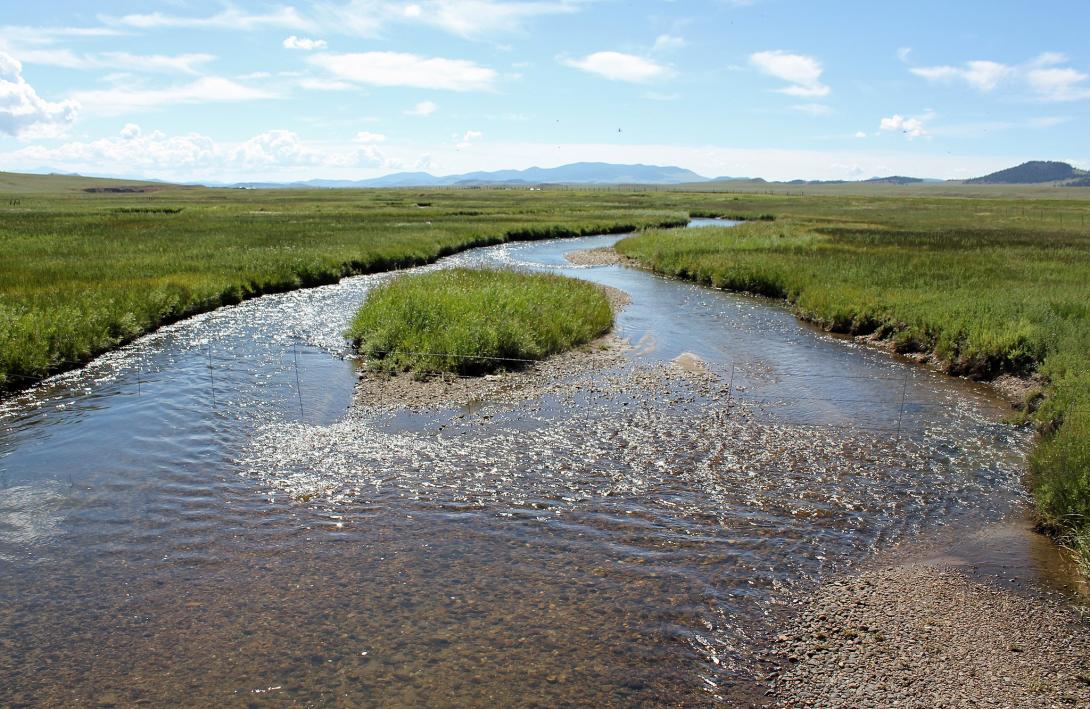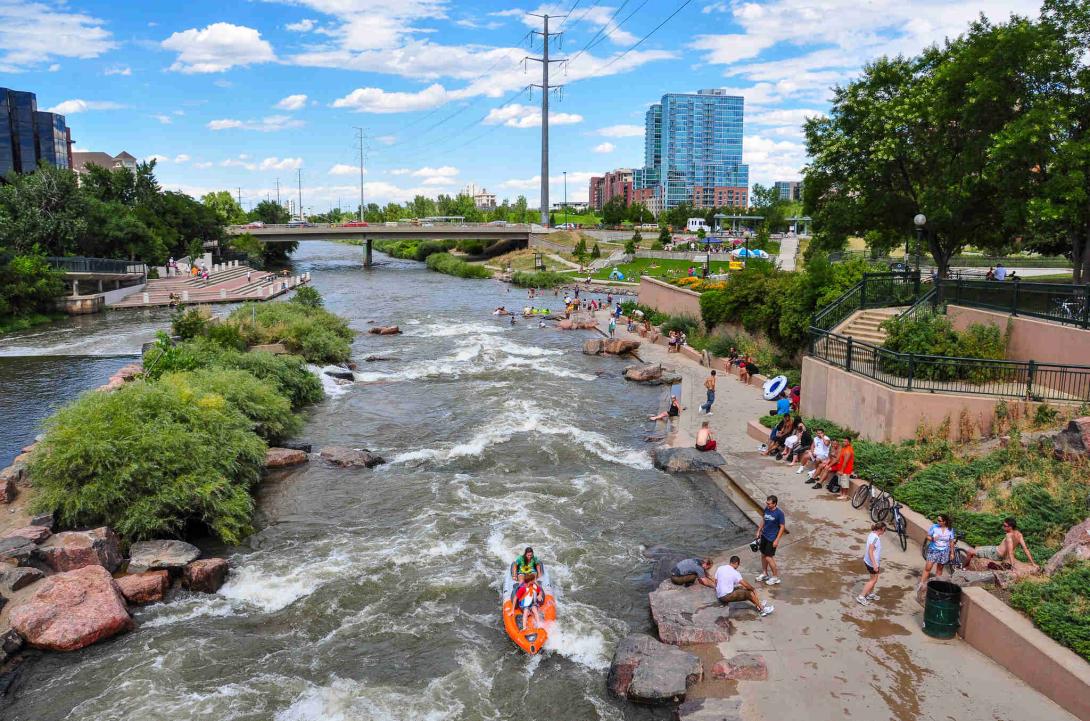South Platte River
Full Article
The South Platte River flows from its headwaters in the Mosquito Range west of South Park across Colorado’s northeastern plains. From downtown Fairplay to the Nebraska border at Julesburg, its course through Colorado is approximately 380.3 miles.
Today, water administrators and water appropriators exploit the South Platte as infrastructure, water source, and livelihood. Whitewater kayakers, fishermen, and duck hunters recreate along the river. For thousands of years, wildlife and people have counted on the river for sustenance, shelter, and as an indivisible extension of their lives. As of 2015, over 4.5 million Coloradans rely on the South Platte for drinking water, irrigation, food, energy, mining, manufacturing, and many other activities, even though most are unaware of that dependence.
Despite insistent human engineering, the South Platte remains dynamic—one of the state’s most ever-changing manifestations of weather, gravity, geology, physics, chemistry, living systems, time, and many other forces, seen and unseen.
Physical Character
The waterway we today call the South Platte once exited the mountains and took a direct eastbound course. Then, 28 million years ago, the North American Plate underwent a slight bowing that lifted the High Plains to the east, forcing the river to carve a fresh northern trajectory through a new topographic depression called the Colorado Piedmont. Fewer than 5,000 feet in altitude, the piedmont is lower in elevation than both the mountains to the west and the High Plains to the east. The South Platte channeled through the softer bedrock nearer the foothills and took in water and silt from Cherry Creek, Clear Creek, Boulder Creek, and St. Vrain Creek.
The river eroded downward and outward along this northbound course until it joined with the Cache la Poudre and Big Thompson Rivers south of Greeley, where it found a low spot and acquired enough momentum to turn east toward the North Platte. From there, its waters move on to find the Missouri River, the Mississippi, and eventually the Gulf of Mexico. In altitude, geology, hydrology, and biologic character, this bend still reflects this exertion.
One traveler wrote in 1849 that it “is hardly possible to guess at the width of the river as we seldom see the whole at once, on account of the numerous islands that are scattered from shore to shore.” These islands were formed during annual mountain snowmelt when peak flows swept gravel and sandbars downstream. Only when flows remained low for extended periods did vegetation stabilize these islands of sediment. Cottonwoods and other riparian trees were then rare, because water was insufficient to support them.
The waterway’s high sediment loads derive from steep peaks at the South Platte River’s high-altitude headwaters. Snowmelt and precipitation gather crumbling granite as water surges downward. Below on the plains, the gravel and sand slows. Thick, permeable deposits of ancient, unconsolidated sand, limestone, sandstone, and silt form the river’s alluvial basin and created an aquifer beneath it. The aquifer, an underground layer of permeable rock that holds an estimated 10 million acre feet of groundwater, shadows the river’s trajectory through northeastern Colorado. The shallow water pocket is between one and fifteen miles wide and ranges from 20 to 200 feet deep.
Human Impact
Wildlife gradually wore paths along the South Platte. Their tracks were joined by the imprints left by various Native American groups, from Paleo-Indian people to the Upper Republican and Itskari cultures and, more recently, the Kiowa, Cheyenne, and Arapaho. Arapaho people recognized the distinctive river as Niinéniiniicíihéhe'. Both the Otoe and Omaha tribes used words for “flat water” to describe it (Nibrathka and Nibthaska respectively). The broad, braided floodplain—where multiple shallow meanders divided and recombined along long, wide stretches—left the same impression on French trappers, who called it the Platte, the French word for “flat.”
After gold was discovered near the river’s confluence with Cherry Creek in 1858, Native American trails were widened into the South Platte Trail, a major immigration corridor to Denver and the mountains. The newcomers ferried wagon trains across the swampy-bottomed waterway, and sand and mud underfoot so tired stagecoach horse teams that they were often changed out for mules.
Hard-going as the trip westward was, many Anglo- and European-Americans believed that the South Platte Basin could become great farmland. Beginning in the 1860s farmers dug long ditches and canals to deliver irrigation water strategically. The agrarian economy fed prospectors and settlers. Front Range cities grew in spite of the aridity. Before statehood in 1876, water scarcity drove the territory to adopt the Colorado Doctrine, a system of water allocation whose essential premise was “first in time, first in right.” Ten years into statehood, however, the Platte was already over-appropriated. Ambitious Coloradans contrived that the river might be better controlled, better used, and better filled to accommodate more productivity and more people.
Before the end of the nineteenth century, laborers doggedly constructed the Grand River Ditch, which would eventually divert 20,000 acre-feet of water from the Western Slope east over the Continental Divide into the Platte, in order to irrigate what would become thriving farms and ranches in northeastern Colorado.
Twentieth-Century Development
By 1957 agricultural interests along the Platte—including the sugar beet industry—benefitted from a US Bureau of Reclamation project called the Colorado–Big Thompson Project, which imported over 200,000 acre-feet of Colorado River water annually, this time through the Continental Divide. Five years later, Denver Water completed the largest of its several reservoirs, Dillon Reservoir, which diverted Western Slope water through the Roberts Tunnel to the North Fork of the South Platte River. The reservoir effectively doubled Denver’s water storage capacity, and both projects generate hydroelectric power. Front Range development continued. Western Colorado’s water resources were fewer, but the South Platte would no longer dry to a trickle.
Aquifer Use
Simultaneously, farmers and ranchers began using the South Platte Aquifer’s groundwater to supplement operations during the drier summer. Two bursts of well digging occurred, one during the Dust Bowl of the 1930s and another during the drought of the early 1950s. These wells connected tributary groundwater with surface water. The use of both surface and groundwater— which is called conjunctive use—expanded the water supply but also introduced administrative challenges. When groundwater is pumped from a well, it depresses subsurface water levels in the shape of an inverted cone, called a cone of depression. A post-pumping depletion, usually measured in the river, is the amount of water depleted by pumping. Accurately measuring cones of depression underground and post-pumping depletions in the river can be inexact, because so many variables are involved. Legislation, court cases, and regulation from the 1950s through the present demonstrate that groundwater administration is an evolving science.
Urban Water Source
With the South Platte as the principal water source, development burgeoned on the Front Range. In the last years of the twentieth century, paved surfaces between Denver and Fort Collins increased by almost a third. Irrigated cropland declined by a third, and wetlands declined by 65 percent. All of these impacts altered permeability and drainage, affecting basin recharge and river flow. With imported water from the Western Slope and conjunctive use of surface and groundwater, an average of 1,400,000 acre-feet flowed through the South Platte annually by 2015. Yet Coloradans between Fairplay and Julesburg use and reuse several times that amount. A higher amount of water users, particularly in urban areas, has intensified the market for water rights, raising both the cost of an acre-foot of Platte River water and the cost of legally defending it. Agricultural interests—both individual and associated—have trouble competing with better-funded municipal and industrial users.
Over a century’s worth of water storage and transport features are themselves growing in size and number, transforming the South Platte’s once-wild mountain canyons into lakes and the meandering river on the plains into a supply and effluent channel between reservoirs. Plentiful water treatment facilities, water recharge ponds, diversion structures, pipes, and canals are visible from the air as well as on the Colorado Division of Water Resources’ “straight-line diagram.” This administrative tool helps the division allocate water diversions by volume and according to priority date. Because it marks water-in and water-out as if the river were a stationary object, not a robust, dynamic river on which diverse organisms depend, environmental limitations of the straight-line diagram may become evident.
Today
The South Platte River, contested and micromanaged, is nevertheless continually changing its form. Unexpected variations range from tiny to grand. A single branch felled by a beaver might precipitate a meander, which may dislodge sediment that creates sandbars with fresh stands of willow and snowberry, where birds and other animals can thrive. At the other end of the spectrum, a weather system can gather in a distant place, then blow toward the Rockies to create a powerful deluge. Sometimes, as in September 2013, the deluge is severe enough to tear away bridges, houses, and other human-made structures, as well as wash otters and other animals many miles downstream. Thus, events small and large still affect the waterway dramatically and unpredictably. Like all geographic features closely examined, the South Platte River has infinite surprises.














